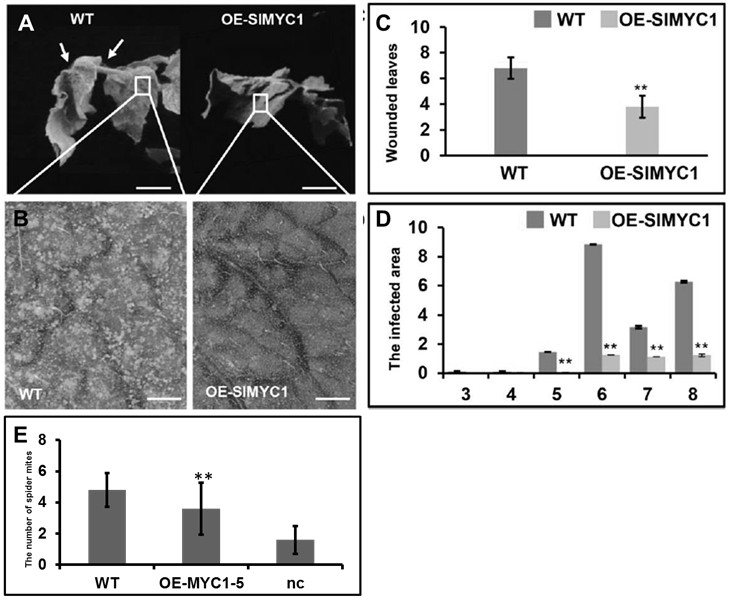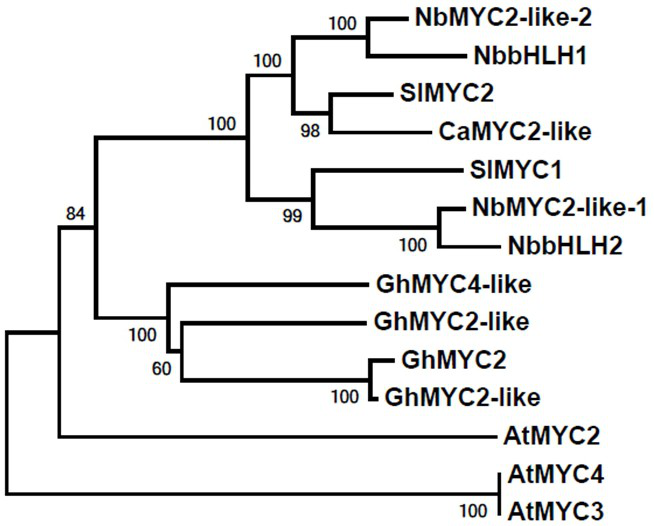Method for increasing content of terpene substances to improve insect resistance of tomatoes
A technology of insect resistance and terpenes, applied in the field of agricultural biology, can solve the problem of loss of genetic resources of tomato
- Summary
- Abstract
- Description
- Claims
- Application Information
AI Technical Summary
Problems solved by technology
Method used
Image
Examples
example 1
[0030] Example 1: Construction of MYC1 overexpression system
[0031] RNA was extracted from tomato leaves according to the instructions of OMEGA's E.Z.N.A.® Plant RNA Kit. According to the instructions of TransScript All-in-One First-Strand cDNA Synthesis SuperMix for qPCR (TRANS), it was reverse transcribed to obtain tomato leaf cDNA. Find the cDNA sequence of MYC1 on the tomato genome website (https: / / solgenomics.net / ), and design primers:
[0032] SEQ ID NO.2 MYC1 (+): 5'-CATTTGGAGAGGACACGCTCGAGATGACGGACTATAGATTATG GAGTA'3 and SEQ ID NO.3 MYC1 (-): 5'- TCGCCCTTGCTCACCATGAATTCTCGCGATTCAG CAATTTTTG -'3; tomato cDNA as template, primer SEQ ID NO.2 Using SEQ ID NO.3 as a primer, PCR amplifies the cDNA target fragment of MYC1, and the obtained target fragment has a size of 1893 bp, and its nucleotide sequence is shown in SEQ ID NO.1. Recover the target fragment, and connect the recovered fragment to the expression vector pHELLSGATE8 (universal vector) through In-fusion reacti...
example 2
[0033] Example 2: Establishment of plant expression system
[0034] (1) To prepare GV3101 Agrobacterium competent cells, the pHELLSGATE8-MYC1 The expression vector was transformed into GV3101 Agrobacterium competent cells, and the positive colonies were screened on LB plates containing a final concentration of 100 mg / L spectinomycin, 50 mg / L rifampicin and 15 mg / L gentamicin;
[0035] (2) After tomato seeds are sterilized, prepare for transformation after germination;
[0036] (3) Prepare Agrobacterium carrying the target gene, and shake the bacteria in large quantities at 28°C with liquid LB medium containing spectinomycin, 50 mg / L rifampicin and 15 mg / L gentamicin at a final concentration of 100 mg / L , shake to OD 600 =1.2~1.6. Centrifuge Agrobacterium at 2000 r / min for 10 min, collect the bacteria, and resuspend Agrobacterium in MS solution (OD 600 =0.8), to obtain the Agrobacterium suspension.
[0037] (4) Infect the explants cut from tomato cotyledons with the Agrob...
example 3
[0055] Example 3: Verification of plant phenotype after expressing MYC1
[0056] The functions of MYC1 and its homologous genes are very conserved in plants, and the homologous gene MYC2 is a key regulator of jasmonic acid signaling in Arabidopsis. We overexpressed MYC1 in tomato and found that MYC1 can significantly increase the content of terpenes in tomato, thereby improving the resistance of plants to biotic stress.
[0057] (1) After obtaining MYC1 overexpressing plants, use real-time quantitative PCR to screen tomato plants stably overexpressing MYC1 ( figure 1 A), after four weeks of plant growth, taking pictures with a camera showed that MYC1 overexpression (OE-MYC1-4) had no significant effect on plant growth and development ( figure 1 B).
[0058] (2) Take the leaves from the same part of the four-week-old plant, extract the RNA of the leaves, and conduct quantitative analysis on the TPSs gene responsible for the synthesis of terpenes in tomato. The results show ...
PUM
 Login to View More
Login to View More Abstract
Description
Claims
Application Information
 Login to View More
Login to View More - R&D
- Intellectual Property
- Life Sciences
- Materials
- Tech Scout
- Unparalleled Data Quality
- Higher Quality Content
- 60% Fewer Hallucinations
Browse by: Latest US Patents, China's latest patents, Technical Efficacy Thesaurus, Application Domain, Technology Topic, Popular Technical Reports.
© 2025 PatSnap. All rights reserved.Legal|Privacy policy|Modern Slavery Act Transparency Statement|Sitemap|About US| Contact US: help@patsnap.com



